Eric C. Sheninger's Blog, page 22
February 7, 2021
Tips for the Socially Distanced Classroom
Schools have either made or are about to make the transition to some sort of hybrid model. The transition is not an easy one. Just ask those who have already been through it. In the midst of adversity and limited training, educators have valiantly risen to the occasion like they always have. With the proper safety measures in place, students have been welcomed back into classrooms. For many, this was desperately needed as the distractions and challenges at home impacted their learning. They wanted and needed their teachers. I would also wager that the adults felt the same about them.
Depending on the hybrid model selected, different challenges arise. However, no matter the path taken, one consistent element is the need to social distance to keep everyone safe. I have noticed in several schools where I am coaching that a natural reaction has been an emphasis on the whole group. Desks are arranged in rows to take precautions, while the primary strategy is direct instruction. Under the current circumstances, I am not saying this is an ineffective means to facilitate a lesson. However, there is a need to ensure that learners are both engaged and empowered during whole group. Getting all students involved, both face-to-face (F2F) and remote, is essential.
Below are some strategies that can be implemented right away when using direct instruction:
Facilitate checks for understanding or closure through the use of mini-whiteboards or technology. Students would need access to one or the other, but this is a great way to foster student voice as a high-agency strategy. Some excellent digital options are PearDeck, Nearpod, and Mentimeter. You can even use self-graded Google or Canvas Forms.Randomly call on kids (both F2F and virtual).Integrate movement using tools like Go-Noodle. F2F students can stay by their desks while remote learners can dance away in the comfort of their own homes. Keeping kids distanced doesn’t mean we can’t find ways to get them up and moving.Utilize conversational strategies such as think-pair-share and turn & talk facilitated through videoconference breakout rooms. Even in a hybrid model, getting kids to talk to one another through essential questions is critical. The use of breakout rooms keeps kids socially distanced while also creating an equitable environment where remote kids get the same experience. After the activity, digital tools can be used where all kids can share their responses.While there is a tendency to rely more heavily on one-size-fits-all methodologies, educators can still use effective pedagogies that were commonplace prior to the pandemic. Once whole group elements are finetuned, educators can begin to integrate more personalized options to empower learners while keeping them safe. While most will be done independently, the digital space provides the environment for cooperative experiences. Here are some ideas to consider.
Differentiate tasks to meet the needs of each learner while moving away from a blanket approach.Facilitate collaboration through the use of digital tools. There are so many options out there, but Padlet, Jamboard, and Google Docs are always good choices.Develop pedagogically-sound blended learning through either choice boards or playlists. These can be used to differentiate but also free up the teacher to provide targeted instruction or one-on-one support. Both strategies allow learners to work in a self-paced format.Leverage any adaptive learning tools that have been purchased. Look at some free options. HERE you can find a list.
Social distancing does place an added stress on teachers. The good news is that many effective practices that were used before the pandemic have just as much value, if not more, in the current environment. Engaging learners and ensuring they are all actively involved during direct instruction will mitigate off-task behavior while setting the stage for increased motivation. From here, the stage is set to implement some personalized strategies that support various learning modalities and needs.
Stay safe, everyone, and keep up the great work. Your efforts are appreciated.
January 31, 2021
A Message to School Leaders
A great deal has been written on the heroic efforts of teachers during the pandemic. I, for one, have penned my fair share of posts that highlight the exceptional work they have and continue to do under extraordinarily challenging conditions. They continue to overcome daily obstacles as every day feels like a trial by fire ordeal. It’s tough to understand the challenges they are going through unless you walk in their shoes for a day. We owe them all a debt of gratitude that should extend well into the future after the virus has been controlled.
Flying under the radar in many cases are school leaders. The pandemic has also placed immense stress on them as they balance support for teachers and meeting the demands of stakeholders. As I work with schools on hybrid learning, I see firsthand the immense pressure on leaders to solve what seems like endless challenges that come from every direction. During a recent coaching visit, the time was spent strategizing ways to support students who are struggling as well as figuring out how to get remote learners to attend classes. These issues are not new by any means but have been amplified as the pandemic has worn on over time.
Many leaders are desperate for ideas that can help their staff and students. You might not see it, but many are at a breaking point. Here are both a message and recommendations based on what I have witnessed and learned firsthand in schools since the onset of COVID-19:
Don’t think you need to do it all yourself.Prioritize time, standards, and SEL needs.Continue to advance learning and equity in your schools with professional development.Know and appreciate the impact you have.
No one has all the answers or even the best ones. Keep in mind that strong leaders ask for help and admit when they don’t know something. In this day and age, it is critical to rely on our best resource – each other. Leveraging other leaders, both externally and internally, to assist with overcoming challenges just makes plain sense. Consider tapping into the expertise of a global network through a Personal Learning Network (PLN). When appropriate, delegate tasks to build capacity on others while lessening the load on yourself. Finally, focus energy on the most vital tasks.
Keeping our sanity while reducing both stress and anxiety are paramount. Prioritizing what is truly important sends a powerful message to teachers. In a recent post, I outlined specific give and take strategies that can be used to free up time, focus on the most critical standards students need right now, and address mental health concerns. The latter is so important for teachers and students. When looking out for others, please don’t forget to address your own social and emotional needs. Taking care of yourself allows you to do the same for others, but your own family will greatly thank you for it.
In the midst of adversity, opportunity arises. We have seen so many educators innovative their practice in such a short period of time, especially regarding the purposeful use of technology. Many valuable lessons have been learned during the pandemic that has set the stage for scalable change that benefits all learners. One of those is the embracement of more personalized approaches to ensure equity where all learners get what they need, when and where they need it. While progress has been made in many schools, there is always a desire and a need for job-embedded professional learning that is practical and on-going, something that I emphasize in Digital Leadership. Learning is the fuel of leadership. Effective leaders engage in it continually while also providing options for their staff to do the same.
Finally, it is difficult at times to realize the impact that a leader has when every decision either doesn’t feel right or is second-guessed. There are no easy or straightforward solutions. Focus first and foremost on creating a nurturing environment for all kids. Ensure you are there for your staff by listening to concerns and addressing them to the best of your ability. Take needed action on behalf of those who you serve. Showing up and trying is more important than you know. Believe in your abilities and the impact that you have. You might not see it, but the rest of us do. Thanks for your efforts, and keep up the great work.
January 24, 2021
All Hands On Deck Approach to Connecting with Families
The pandemic has brought to light numerous challenges, many of which were known prior to the rapid spread of COVID-19, that have rocked our world. Equity, primarily digital, might be at the top of the list. More than ever, schools realize that to facilitate learning in equitable ways, they must provide all learners with personalized supports. Another pressing challenge is engagement both in and out of the classroom. Having the right pedagogy in place is a critical step in keeping those who are attending classes, either remote or face-to-face, engaged. However, it is impossible to overlook the need to assist further those who are currently failing or not showing up at all.
A great deal has been researched on this topic over the years and has provided some crucial aspects to remember. Regardless of family income or background, students whose parents are involved in their schooling are more likely to have higher grades and test scores, attend school regularly, have better social skills, show improved behavior, and adapt well to school (Henderson & Mapp, 2002). Engagement strategies need to start early and be sustained. During elementary school years, parent partnerships build a strong foundation for student success and future engagement opportunities (Dearing et al., 2006). The goal is to have kids engaged in class, but we need to ensure that they are actually attending. Even after accounting for grade level and previous absences, students with engaged parents report fewer days of school missed overall.
There is a great deal more research out there that makes the connection between student outcomes and family engagement. As leaders are experiencing difficulty with engaging families across the globe, an “all hands on deck” mentality in terms of the strategies utilized should be embraced. In a recent post, I provided some detail on ideas that have gained traction during the pandemic. While these are definitely useful, I am always on the lookout for even more to assist the district and schools I work with on an on-going basis. Below are some additional strategies to employ for your consideration:
Houses of worshipParent-Teacher Organizations (PTO’s)Local businessesAlumni networksMainstream mediaTips from learners who are thriving
Houses of worship are an untapped resource. While many families are not engaging with their schools, they are still attending religious services. Herein lies a great opportunity to provide important messages for families that the leader of the service can read. This idea also solves a problem with language barriers as many houses of worship speak in the native language depending on the denomination. Another community resource is local businesses. When I was a principal, I always left paper flyers on the checkout counter and even asked to display some in the windows. If you have not tapped into these two resources, I hope you now will.
PTOs and alumni groups are also excellent pathways to get information out. Since each group has unique relationships with families, I leveraged them to distribute emails, paper flyers, and social media posts. While each group was impactful in its own way, the mainstream media had a different type of influence that could not be overlooked. As such, I was always reaching out to newspapers, radio stations, and televised news networks to get powerful stories out there that would improve connections with families. Do you know what makes a great story that can be shared with the media and through your own channels? Tips and ideas from learners who have excelled during the pandemic! Getting their insight is invaluable, in my opinion.
Digital leadership calls for a multi-faceted approach to engage families where they are the leads to some form of two-way communication. Please don’t discount any strategy that can help make a connection, as the impact could be priceless if it helps our learners. I hope you will consider sharing in the comments below specific actions that you have taken that have led to a positive outcome with families. Stay safe, everyone, and know that your work really matters.
Epstein, J.L., & Sheldon, S.B. (2004) Getting Students to School: Using Family and Community Involvement to Reduce Chronic Absenteeism. School Community Journal, 14, pp 39-56.
Dearing, E., Kreider, H., Simpkins, S., & Weiss, H. B. (2006). Family involvement in school and low-income children’s literacy performance: Longitudinal associations between and within families. Journal of Educational Psychology, 98, 653-664.
Henderson, A. T., & Mapp, K. L. (2002). A new wave of evidence: The impact of school, family, and community connections on student achievement. Austin, TX: Southwest Educational Development Laboratory
January 17, 2021
Modeling Hybrid Learning to Support Educators
Hybrid learning continues to be on the minds of schools and districts. Either they are beginning to get ready to shift from remote learning, or challenges have arisen after meticulously planning for a smooth rollout. In either case, I commend them for seeking out assistance for staff to ease concerns and ensure sound pedagogical practices are in place. These models were never meant for K-12 education, and there is no definitive playbook available as things seem to be in a constant state of flux during the pandemic. Educators have admirably risen to the occasion, but that doesn’t mean they don’t deserve continuous support, practical strategies, and timely resources. Investments now will serve to provide needed assistance while paving the way for sustainable changes to pedagogy in the future.
To this end, I hit the ground running to begin the new year by traveling to Oklahoma to work with Sapulpa Public Schools. Like virtually every district and school, educators were experiencing some challenges with hybrid learning. During my first session of the day, I worked with administrators to best support their teachers. As I was on-sight with them in a socially distanced cafeteria, I facilitated a more traditional workshop. I combined practical strategies aligned to the current situation combined with multiple opportunities to discuss essential questions and then share responses using digital tools. However, something was off as I felt that I really wasn’t showing them the reality of what their teachers were expected to do in their classroom with remote and face-to-face students simultaneously. Thankfully this changed for my next session.
I knew that I was going to have the opportunity to work with all district teachers on hybrid learning and encouraged them to attend the session as well. In my mind, this was the perfect opportunity to model pedagogically-sound hybrid learning in a way that was manageable yet effective. The scenario turned out to be perfect as I had approximately 200 teachers join remotely on Zoom and had another 50 or so socially distanced in the auditorium. I was pumped to do my best to replicate what teachers experience currently in their classrooms with hybrid learning in order to address challenges and lessen anxiety. I cannot overstate the importance of modeling strategies for teachers and administrators under the same conditions that they deal with daily.
Using a toolbox of ideas and strategies developed during the pandemic in my work with schools, I facilitated the workshop using effective instructional strategies, essential questions, breakout rooms, and digital tools in ways that I outlined in my last post. I stressed how I wasn’t doing anything radically different from what successful teachers did prior to the pandemic throughout each activity. For example, I chunked the content shared and infused numerous interactive tasks for discourse and collaboration. As they worked in groups, I moved about the room and monitored progress physically while also checking in on the remote learners. After a set amount of time, all of the attendees shared their responses and reflections using various digital tools. After focusing on practical pedagogy, we ended with some ideas on transitioning to more personalized approaches through blended learning.

The feedback afterward presented validation for how I structured the workshop. First and foremost, I wanted everyone to understand that the key to any hybrid learning model is creating an equitable learning experience. Whether an attendee was with me remotely or face-to-face, they all were engaged and empowered through the same activities. I can state how critical this is for our learners. We need to make them feel a part of the lesson. The second takeaway was not to overthink things but to keep it simple, as outlined in this post.
All in all, we get what we model. Educators desperately want and need support with hybrid learning. The best way to get results is to model both expectations and strategies while also creating norms to ease anxiety levels. If you need additional support here in the United States, look no further than available Every Student Succeeds Act (ESSA) Title II and IV funds. The criteria stipulate the use of technology to improve learning outcomes. Feel free to reach out at any time (esheninger@gmail.com) to discuss the work I have been doing with schools and what I can do for you. Keep up the excellent work, everyone!
January 9, 2021
Making Headway with Remote and Hybrid Learning
With 2020 in the rearview mirror, it is now time to focus on the present with an eye to the future. Many difficult lessons were learned during the pandemic, and a few more are sure to materialize over the next couple of months. Even though educators have been challenged like never before, they faced adversity and stepped up to the plate admirably for their learners. While a great deal can be written about the challenges experienced and those still prevalent, I want to focus on some of the good that has come out of the COVID-19 nightmare. Remote and hybrid learning at scale was never meant for K-12 education, but the fact remains that each has been a catalyst for some exciting changes that have long been overdue.
As I recently worked with leaders from Paterson Public Schools in New Jersey, during a coaching session, I asked them to take a few minutes, and each share something positive that came about as a result of the pandemic. Too often, we tend to dwell on overcoming hardships that we forget to celebrate both small and large wins. With morale at a breaking point now more than ever, teachers and administrators need validation for all they have done recently. These can become critical building blocks for sustainable change.
As each leader presented their views on positive shifts to practice, you could see their pride swell. They shared how teachers got better using technology, reached out more for feedback, collaborated more, and improved classroom management. They also shared that the facilitation of professional learning improved, a greater reach was achieved thanks to technology, previously unknown teacher strengths were unearthed, and there was the ability to get into more classrooms. All in all, these are all great examples of progress in difficult times. How has your practice or those in your school/district changed for the better?
As the new year begins, schools, for the most part, are still where they were in 2020. That is why it is imperative to celebrate success in any form and provide further support for teachers and administrators. Instead of dwelling on all that hasn't worked, energy should be spent on all that has during the pandemic. Consider these questions from your lens. What are your exemplars of effective remote or hybrid teaching and learning, and why? How are you sharing these with colleagues and staff or using them for professional learning and feedback? While these provide ample opportunities to reflect, further headway can be made by focusing on the following:

Continuity and consistency – Keep it as simple as possible. Embrace a learning management system (LMS), settle on a video conference solution that has breakout rooms and integrate one digital tool that aligns with effective instructional strategies. Then be sure to use consistency and ensure there are continuities either across your school or K-12.Lesson structure – The key here is to ensure there is a balance between synchronous and asynchronous activities both with and without technology. Other considerations include chunking how content is presented, utilizing routine checks for understanding, providing brain breaks, and incorporating movement activities. Engagement issues arise when it is entirely direct instruction, or learners are expected to be on technology the entire time. HERE are some ideas on how to balance things out.Relevance – Learners need purpose. Without this, the willingness and desire to learn dwindles. An anticipatory set at the beginning of every lesson is a great start, but they're also should be at least one opportunity to apply thinking in a relevant way. Kids become intrinsically motivated when they know why they are learning something and how they will use what has been learned outside of school.Rigor – Any remote or hybrid experience should challenge students to think. Consider how questions are scaffolded and the way in which knowledge will be applied to solve complex problems. The ability to think, pandemic or not, is the best way to future-proof learning for all students while setting them up for success. Purposeful use – Technology has played a considerable role during the pandemic and will continue to well after. However, just using Zoom to "deliver" instruction should not be the goal and does not constitute effective use. Now is the time to focus on purposeful use aligned to sound instructional strategies (review of prior learning, checks for understanding, closure, assessment). From here, it is about empowering students to use technology to learn in ways that they couldn't without it.Blended learning – One of the best ways to incorporate all of the above is through blended pedagogies. Often, though, there is confusion as to what this really is. Blended instruction is what the teacher does with technology. Blended learning is where students use tech to have control over path, place, and pace while also having voice and choice. Consider practical strategies such as station rotation, choice boards, playlists, and flipped lessons.Leverage your superstars – There is no better way to make headway with remote and hybrid learning than to put the work of your trailblazers' front and center. Consider sharing what they are doing in email blasts and through social media. Not only can they serve as motivation for teachers who yearn for practical strategies, but their work can also be shared with stakeholders to showcase what is working. Your superstars can also lead professional learning.
What we have and continue to learn during the pandemic will pave the way for sustainable changes to practice that will positively impact kids. Don't sell yourselves short. In the midst of immense challenges and struggles, you have all stepped up in ways that illustrate how amazing educators are. Remote and hybrid learning can work because of your efforts. Continue to keep things manageable while also looking for opportunities to reflect and grow. You don't have to have all the answers or solutions. It is a sign of strength to admit that you don't know or need help in these cases. If this is your situation, please feel free to reach out as I am more than happy to help in any way that I can.
January 3, 2021
Strategies to Accelerate Family Engagement
With all its challenges, the pandemic brought to light the need to either rethink or improve various aspects of practice. When it comes to leadership, the importance of effective communication skills to engage and empower families moved to the forefront. There are many reasons for this, but the most pressing was the need for information related to COVID-19, especially during the early months of the outbreak. The move to remote learning, then a hybrid model, and frequent back-and-forth changes necessitated the need for timely and accessible information.
Over time the emphasis shifted to getting messages to families that student engagement had become a critical issue as the pandemic raged on, even with the approval of two vaccines. Headline after headline acknowledged that tens of thousands of students had yet to log on to any remote classes during the school year. Overall attendance was a major issue as concerns over increasing learning gaps grew. If things weren’t challenging enough, the added stress of a lack of engagement by remote learners on video calls compounded things further. As I write this post, leaders are still currently dealing with these issues.
There is a need to embrace an all-hands-on-deck approach to engaging families right now. A focus on solely traditional methods will not cut it, unfortunately. The same old thinking typically leads to the same old results. Right now, time is of the essence, which is why leaders need to critically reflect on their actions in order to improve the outcomes of any messaging strategy. Below is a quick list of ideas to consider:
Social mediaVideo streaming (i.e., Facebook Live)Notifications (SIS, email, Remind, LMS)Virtual eventsGamesFlyers Infomercials and public service announcementsYard signsTown HallsTestimonials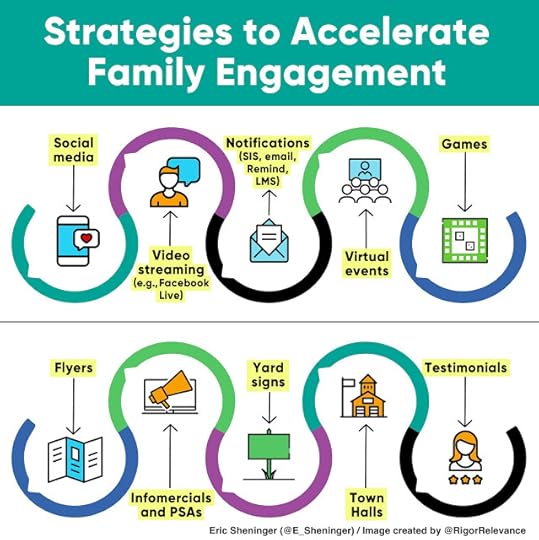
In Digital Leadership, I wrote about the fundamental need to meet stakeholders where they are and engage them where they are using a multi-faceted approach. Herein lies why social media has to be a critical component of any strategy. However, leaders must also look beyond Twitter and Facebook and begin to utilize more popular tools now being used by families such as TikTok, Snapchat, Instagram, and Pinterest. Each of these has the ability to harness the power of images and videos to capture attention while delivering powerful messages. Any tool with video capacity can be used to push out infomercials that highlight both positive aspects of current school culture or pain points. Consider having students help you create these. Many leaders have turned to live video to not only get information out but to engage families on a weekly basis through the facilitation of town halls where questions are answered.
Testimonials from students and parents on successful remote or hybrid learning practices can also be shared using social media. With virtual events, leaders can provide insight into how remote and hybrid learning is just as meaningful and challenging as face-to-face. Consider using this strategy as an open house of sorts. Another tried, and true technology option is messages sent through both your student information system (SIS) and learning management system (LMS) as well as Remind. Each can be set up to send out both email and text messages. Back when I was a principal, we embedded critical information on student report cards using our SIS.
The list above also includes some non-tech options to engage families. It is important to note that digital equity is still an issue, and we cannot assume that everyone can be reached using email or social media. Paper flyers still have value. Sending them through the mail is always an option, but those whose students continue to either not attend school or be disengaged try taping them to the front door. I know this might seem a bit unconventional and a hassle. However, the fact remains that all options need to be on the table. Some schools have gone as far as installing yard signs to hammer the point home that kids need to attend classes and complete schoolwork. Another idea is to use games such as bingo with incentives such as school swag for families that participate. The example below could be adapted in such away.
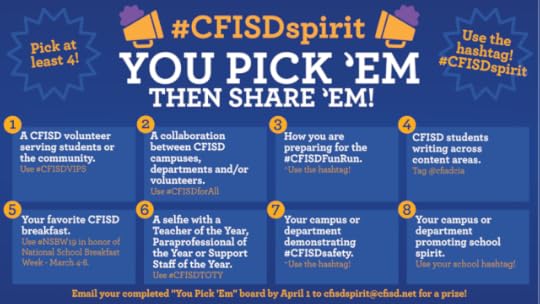
The list I provided outlines a variety of strategies leaders can use at any time to improve family engagement. Keep in mind the importance of creating messages that resonate. In BrandED, we outlined the importance of promise, result, and image when developing an engagement strategy.
PROMISE
... A compelling core connection to the value we guarantee to our community
RESULT
...A consistent reason to believe by our community
IMAGE
...Identity that grows awareness of the good we accomplish
As you work to craft both a communications and public relations plan that includes the above elements remember to use the power of stories. Storytelling impacts the brain in ways that make it easier to remember critical messages by tapping into emotions. It also aids in getting important information out to diverse audiences. Beyond the emotional connectivity, strategic thinking about messages shared enables leaders to set measurable goals that establish and ensure long-term trust. Without trust, there is no relationship. Without relationships, no real learning occurs. There is no better time than now to become the storyteller-in-chief!
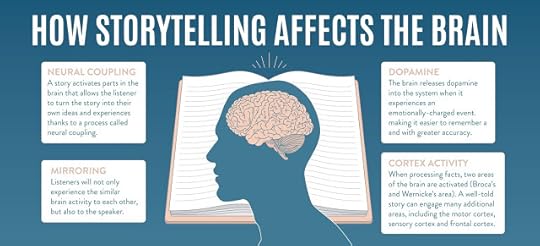
As I work with leaders across the globe, family engagement is consistently one of the top challenges that they face. The ideas in this piece are only suggestions. When it is all said and done, it’s how these and other practical ideas are put into practice and lead to success. For more strategies, consider getting your hands on both Digital Leadership and BrandED.
December 27, 2020
Top Posts of 2020
The year began like any other. From a blogging perspective, I kicked it off with a post on what could be as a means to pump up educators as they continued to move towards embracing innovative strategies and ideas. In my opinion, January always represents an excellent opportunity to try something new. Personalized learning quickly became a focus area based on impressive outcomes from some of the schools I had been working within in an on-going and job-embedded fashion. It is always an honor to share the incredible work of educators in the field. Other pieces included topics that I traditionally cover but with new angles such as pedagogy, change leadership, and school culture.
Everything changed in March, not just for me, but the entire world. The COVID-19 pandemic began to spread like wildfire across the globe. I vividly remember being on vacation in Cabo San Lucas, Mexico, when everything seemed to go downhill overnight. Schools closed their physical buildings and shifted to remote learning as lockdowns went into effect worldwide. My reaction was to take a break from vacation and churn out a blog post focusing on resources that educators could use right away. This happened on March 12, 2020.
Who would have thought that nine months later, the pandemic would still have its tight grip on society? A powerful reminder and lesson, depending on how you look at things, came out of this mess. Even though educators were (and still are in many cases) flying the plane while building it, we learned that a virus could not stop their commitment to kids. If you get a chance to thank an educator today (or any day for that matter), please do. They are working their tails off and performing miracles in many cases. Their pay does not align with the effort, time, and stress they are dealing with during this pandemic. We are in their debt.
From March on, my blog posts focused on practical strategies in the areas of remote learning, hybrid models, and leadership in uncertain times. They were some of my most read pieces ever! What I learned was that educators were craving useable ideas aligned to the current reality. I used this time to learn and grow myself as I had to both adapt and evolve to improve as a presenter, workshop facilitator, and coach. You need to practice what you preach if it is going to have real value in today’s world, and I worked hard to do just that to better meet the needs of those reading my blog.
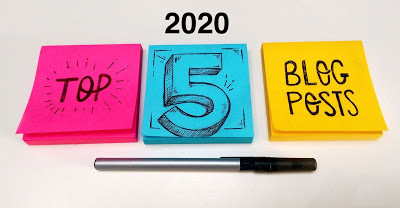
Without further ado, here are my most popular posts of 2020 in no particular order. Instead of sharing a summary of each, I have decided to include the unique image that was developed to accompany the content.
A Pedagogical Framework for Managing Face-to-Face and Remote Learners at the Same Time
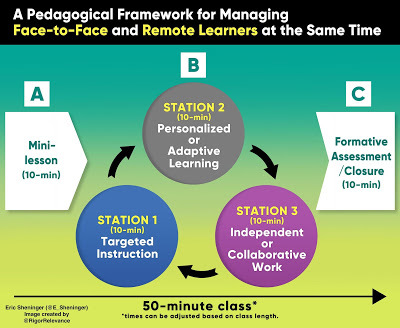
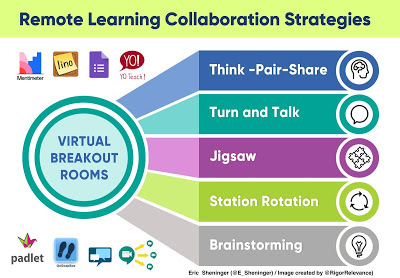
Moving to a Hybrid Learning Model
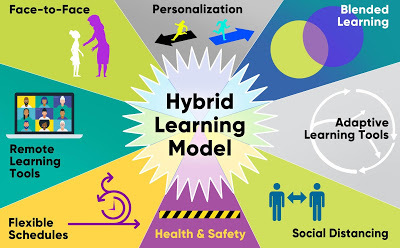
10 Remote Learning Practices to Avoid
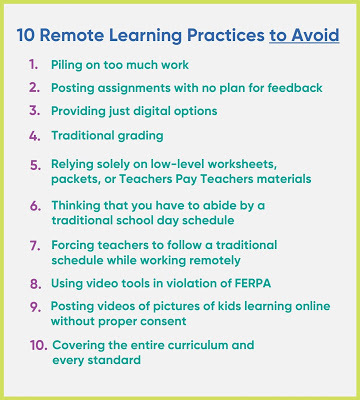
8 Non-Digital Remote Learning Ideas
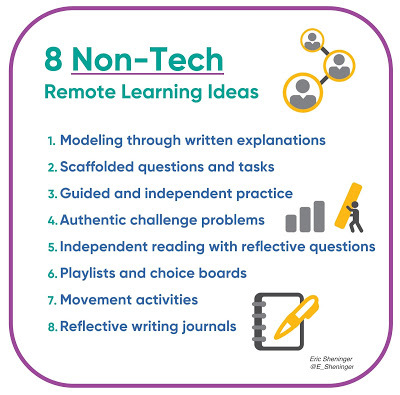
In the face of adversity, resilient educators stepped up like never before. For this, we owe them our gratitude and heartfelt thanks. Some valuable lessons were also learned along the way, with the main one being that the future is bright for education. The pandemic taught us all that needed change can happen more quickly than thought. In 2021 we need to use these lessons to drive systemic change.
December 20, 2020
Challenges Create Opportunities
"Challenges are what make life interesting and overcoming them is what makes life meaningful." - Joshua J. Marine
I love working with educators. Even though I am often the facilitator of learning, I always seek out opportunities to put myself into the shoes of those doing the day-to-day work and then use this as an opportunity to reflect on my practice. The other day I was working with Davis Schools in Utah on a hybrid learning model where educators would be teaching face-to-face and remote learners at the same time. My partner in crime was Belinda Kuck, who is the Director of Teaching and Learning. We have been working closely over the years on personalized learning support for teachers and administrators in the district. I learn so much from her every time we chat.
The premise of the work we kicked off was helping educators and districts manage time and utilize effective pedagogy during these challenging times. It is essential to recognize the fact that a hybrid model was never intended for K-12 education. Thus, providing support in the form of professional learning is something that all districts and schools should be investing in, whether internally or externally. Belinda began each session with an overview of the pilot program where educators would receive both a technology package (digital camera, laptop, microphone, tripod) and on-going professional learning from the International Center for Leadership in Education (ICLE) facilitated by yours truly. The best part of this was how she told the educators that they would be empowered to provide feedback to the district on how to implement the hybrid model best. It's awesome when the voices and ideas of those doing the work are valued.
After the pilot program's premise was shared, there was one more piece that Belinda assigned before I rolled up my sleeves and got to work. She asked each person to share a "peach" and a "pit" from their experiences during the pandemic. At first, I wasn't really sure what she was trying to accomplish with this analogy, but there was some quick clarification. This was a good thing as I had visions of Beverly Hills 90210 in my head. For those of you who never indulged in this 90's classic, there was a restaurant called The Peach Pit that Brandon and the crew frequented. Don't judge me for enjoying the show.
The peach represented something sweet, such as a practice that evolved over the past couple of months. Many of the responses centered around integrating technology, utilizing Canvas more effectively, getting to know students better than in the past, and shifting to more personalized strategies. The pit referred to hardships and challenges. It wasn't surprising that there were more pit responses than sweet. The most common challenges revolved around time, mental health, student engagement, and a learning curve when it came to the purposeful use of technology.

After reflecting on the sessions, something dawned on me. If it weren't for the pit, we would never have the peach. As much as it can be an annoyance when we are enjoying eating the peach, the giant seed in the middle leads to the tree that will eventually bear the fruit. The point I am trying to make in all of this is that challenges, as much as they cause stress and anxiety, lead to opportunities to change for the better. In the face of adversity, educators have and continue to innovate in ways that will benefit learners for generations. It is vital to view challenges as the pit. When they are overcome, it will be such a sweet feeling and hopefully as satisfying as eating a peach. If you don't like eating peaches, then use this analogy with any fruit that has seeds. Keep up the excellent work, everyone!
December 13, 2020
Finding Balance in Today's Classroom
Balance has always been a challenge for teachers. I vividly remember this during my early years as a teacher. Each night I came home exhausted. Maybe the 45-minute commute had a little to do with it, but the main culprit was how I used available time in the classroom. Since I was not very open to risks and convinced that the most critical aspect of my job was to get through the curriculum, my sole focus was on direct instruction. Based on the feedback that I received during formal observations, the consensus was that I was pretty good at it. Nights and weekends were spent at the local office store getting transparencies made for the overhead projector, which was the primary technology tool at the time.
I thought I couldn’t live without the overhead projector and appreciated the fact that it limited my time using the chalkboard. No matter how hard I tried, I would always get chalk all over my sleeves. Then something magical happened in the early 2000s. The science department invested in mobile carts outfitted with television sets. Now, these weren’t your run of the mill flat screens as they hadn’t been invented yet. We were given lovely large box sets that were connected to our desktop computers. With the new tech technology in hand, my days of making transparencies were done, and the overhead projector was retired. Now my time was spent creating PowerPoint presentations for direct instruction.
The short walk down memory lane reminds me of why I was exhausted during my beginning years of teaching. It took some self-reflection and honest feedback from my students to move away from being the sage on the stage and more of a facilitator of learning. Differentiated instruction and cooperative learning strategies became embedded in some form during each lesson. There was also an emphasis on moving to inquiry and project-based pedagogies. After all, I was a science teacher, and the fit was natural. Direct instruction was still a component of most lessons, but it was now limited to no more than fifteen minutes. When I shifted more responsibility to learners in class, a better balance was achieved, and I evolved into a more effective teacher.
I share this story because of what I have either seen or been told is happening in classrooms at this very moment. Advances in technology and the pandemic have placed a great deal of stress on teachers and schools, and the reaction has led to an imbalance in many cases. There has either been a reversion to mostly teacher-centered practices or an over-reliance on technology as a result of remote learning and hard to manage hybrid models. No one is at fault here. In these times, educators want to mitigate risk while keeping their sanity. However, I would be remiss if I didn’t broach the topic as I am frequently asked for feedback and ideas during coaching sessions.
The key is to be reflective in terms of how the lesson is structured and how the time is used. If students are using tech or direct instruction is taking place 100% during the period or block, then there is both a need and opportunity to find some balance with other tasks or strategies. Below are some ideas to balance out activities to ensure greater engagement and set the stage for empowerment through personalization.
Keep direct instruction or the mini-lesson between ten to fifteen minutes.Use varied engagement strategies (click HERE for specific ideas).Utilize digital breakout rooms for discourse and collaboration.Add in movement and brain break activities.Move to pedagogically-sound blended learning and provide a mix of tech and non-tech options.Integrate asynchronous tasks (i.e., self-paced activities) when appropriate and provide individual or small group support to those learners who need the most help.Seek out or ask for professional learning support on remote and hybrid pedagogy.Use the flipped classroom approach and differentiate when you have all your learners live.
Please note that these are just ideas. Finding the right balance is a personal journey that considers available time, supports, and equity. We can all agree that technology allows kids to learn in ways we could never have imagined. However, in times like this, it should not become a crutch. Its role during the pandemic is the same as prior, and that is as a means to support and enhance learning, not drive it. Always value the magic of teaching, something that technology can never replace.
For more remote and hybrid learning resources click HERE.
December 6, 2020
Feedback is Needed More Than Ever
I think we can all agree that this school year has been unlike any other and not for the best of reasons. The pandemic has upended the entire education system as schools have moved to remote, then hybrid, and back to remote in some cases with no end in sight. Even with the promising news of two potential vaccines, rising COVID-19 cases have resulted in a constant state of flux. Continuity and consistency have been hard to come by and finding a groove have become an arduous task in many cases. Educators, students, and families have never been in a situation as challenging as what they are experiencing right now.
The rapid state of uncertainty has caused a great deal of angst, and rightfully so. As a result, there have been increased levels of stress, anxiety, and fear amongst teachers, which has led to decreased motivation in some cases. It’s not that they don’t want to do a good job but more a battle to get through each day. The struggle is real. For students, a lack of engagement on their end has led to significant concerns across the globe. If they aren’t engaged, then the chances that meaningful learning is taking place are slim. Finally, administrators are searching frantically for answers while putting out fires and conducting contact tracing daily.
With all these challenges, growth becomes an afterthought. However, it is a necessity in order to provide the best learning experience possible for kids, even in times of crisis. Through adversity, some of the best ideas are developed and implemented with fidelity. The key to setting the stage for this to occur is a concerted effort to make feedback a daily phenomenon. While assessments, observations, and evaluations might have worked well in the past, a more sensitive approach is not only warranted but also a necessity right now.
Feedback can be a catalyst for motivation, engagement, and finding answers to questions or problems. First and foremost, we must be open to it in some form. One way to move the need is to seek it out from a variety of perspectives. Teachers can engage both students and families in conversations to elicit essential ideas on how to improve remote and hybrid learning experiences. Administrators can do the same with stakeholders and staff in order to gather intel on how to improve school culture immediately. In the classroom, providing regular feedback to learners might be the most critical key to engaging them.
Everyone benefits if we are diligent and sensitive as to how it is implemented as a means both to inform and empower. Below are some aspects to consider regarding quality feedback:
Facilitate with sincerityGround in practicality and specificityGive in a timely mannerDialogue over monologue Focus on positive deliveryUse the right medium(s)Be consistentAlign to advancement towards a goal(s)
Most people want to know how they are doing and what can be done to improve, even it is a small shift in practice or learning. Keep in mind the importance of Maslow’s Hierarchy of Needs. Feedback can be as simple as reassuring others that they are doing a great job in these trying times or using it as a way to find out what might be inhibiting motivation or engagement. The bottom line is that it is a great tool that can be used in a variety of ways. When it is all said and done, its best use might be that of relationship builder. After all, relationships are the foundation of learning and growth, no matter if we are in a pandemic or not.



